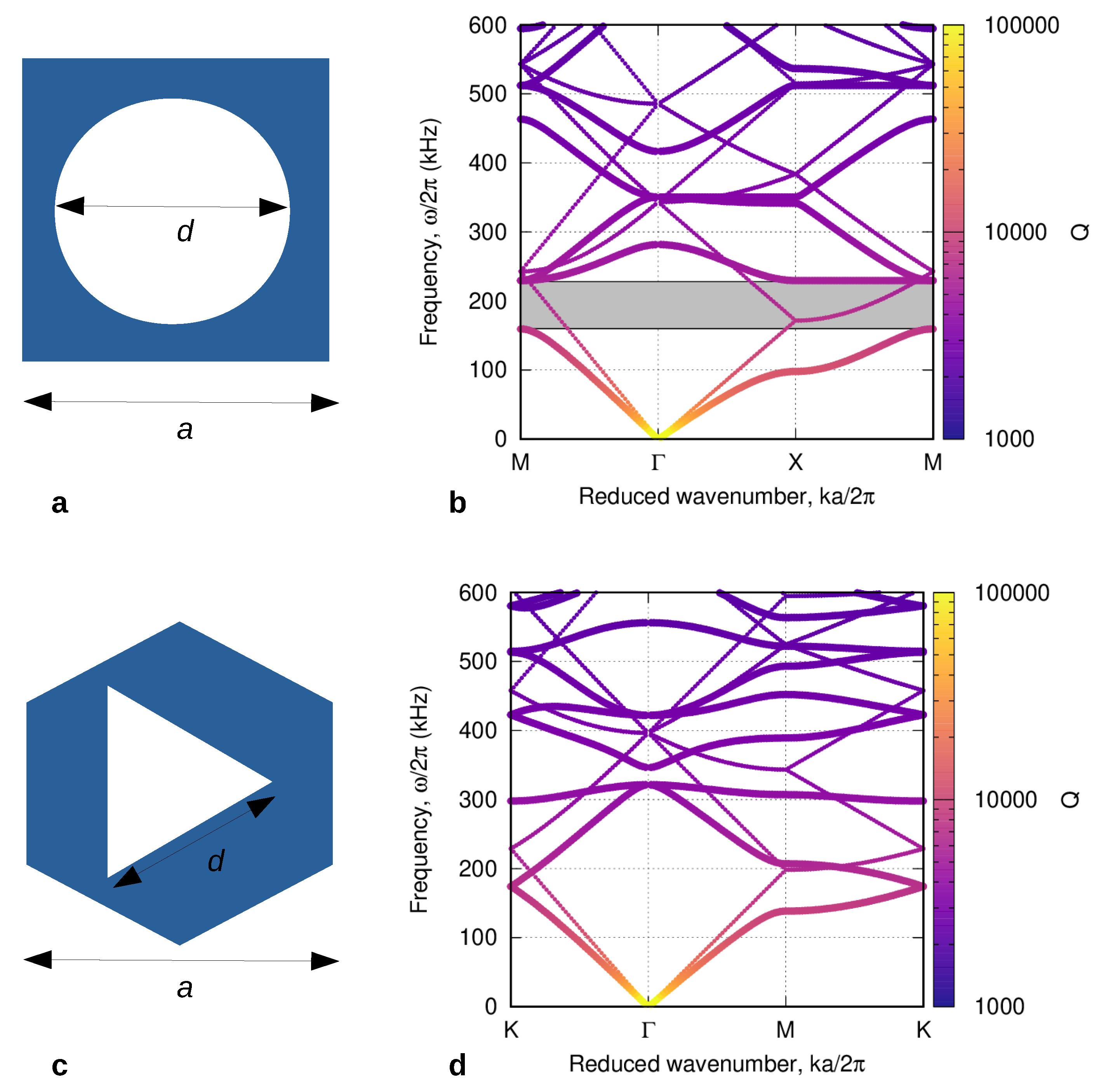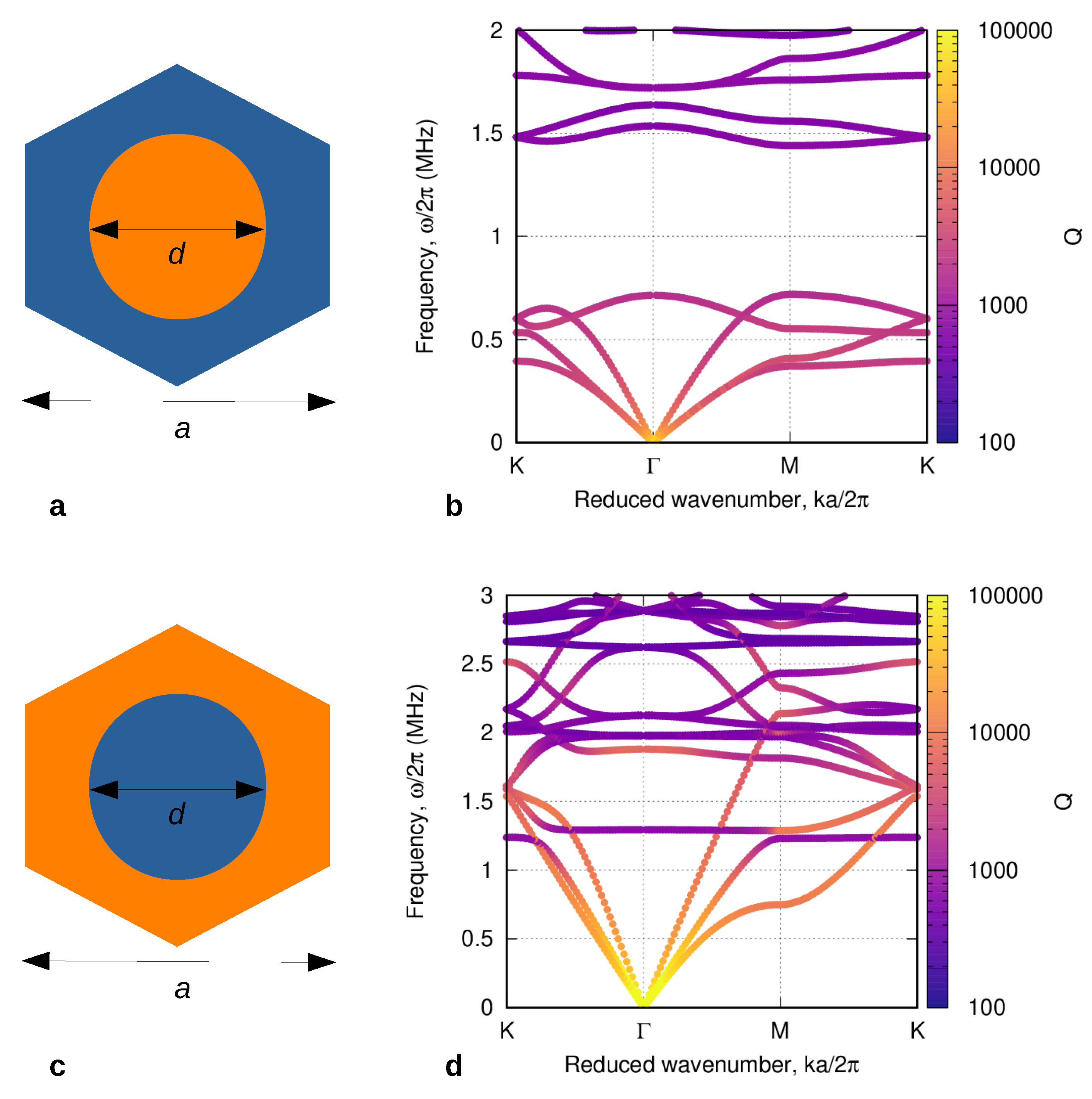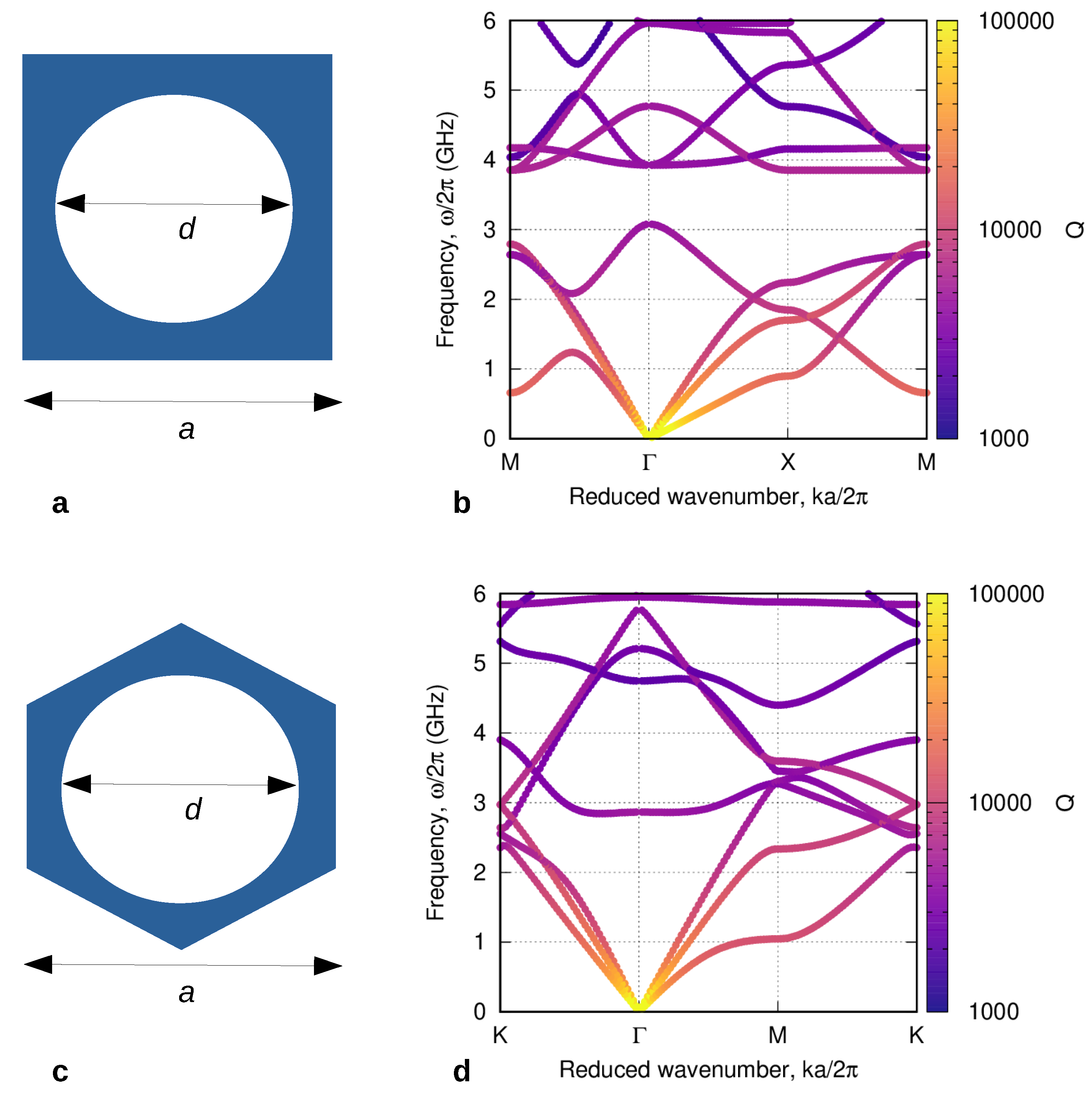Complex-Eigenfrequency Band Structure of Viscoelastic Phononic Crystals
Abstract
Featured Application
Abstract
1. Introduction
2. Theory
2.1. Complex Eigenvalue Problem
2.2. Phononic Crystal Containing Viscoelastic Materials
2.3. Extension to Sonic Crystals
3. Results
3.1. Sonic Crystal of Rigid Rods in Air
3.2. Epoxy–Steel Phononic Crystal
3.3. Phononic Crystal of Holes in Silicon
4. Discussion
Author Contributions
Funding
Conflicts of Interest
References
- Kushwaha, M.S.; Halevi, P.; Dobrzynski, L.; Djafari-Rouhani, B. Acoustic band structure of periodic elastic composites. Phys. Rev. Lett. 1993, 71, 2022–2025. [Google Scholar] [CrossRef]
- Laude, V. Phononic Crystals: Artificial Crystals for Sonic, Acoustic, and Elastic Waves; De Gruyter: Vienna, Austria, 2015. [Google Scholar]
- Auld, B.A. Acoustic Fields and Waves in Solids; Wiley: New York, NY, USA, 1973. [Google Scholar]
- Royer, D.; Dieulesaint, E. Elastic Waves in Solids; Wiley: New York, NY, USA, 1999. [Google Scholar]
- Psarobas, I.E. Viscoelastic response of sonic band-gap materials. Phys. Rev. B 2001, 64, 012303. [Google Scholar] [CrossRef]
- Liu, Y.; Yu, D.; Zhao, H.; Wen, J.; Wen, X. Theoretical study of two-dimensional phononic crystals with viscoelasticity based on fractional derivative models. J. Phys. D: Appl. Phys. 2008, 41, 065503. [Google Scholar] [CrossRef]
- Laude, V.; Achaoui, Y.; Benchabane, S.; Khelif, A. Evanescent Bloch waves and the complex band structure of phononic crystals. Phys. Rev. B 2009, 80, 092301. [Google Scholar] [CrossRef]
- Hussein, M.I. Theory of damped Bloch waves in elastic media. Phys. Rev. B 2009, 80, 212301. [Google Scholar] [CrossRef]
- Merheb, B.; Deymier, P.A.; Muralidharan, K.; Bucay, J.; Jain, M.; Aloshyna-Lesuffleur, M.; Greger, R.W.; Mohanty, S.; Berker, A. Viscoelastic effect on acoustic band gaps in polymer-fluid composites. Model. Simul. Mater. Sci. Eng. 2009, 17, 075013. [Google Scholar] [CrossRef]
- Moiseyenko, R.P.; Laude, V. Material loss influence on the complex band structure and group velocity in phononic crystals. Phys. Rev. B 2011, 83, 064301. [Google Scholar] [CrossRef]
- Laude, V.; Escalante, J.M.; Martínez, A. Effect of loss on the dispersion relation of photonic and phononic crystals. Phys. Rev. B 2013, 88, 224302. [Google Scholar] [CrossRef]
- Wang, Y.F.; Wang, Y.S.; Laude, V. Wave propagation in two-dimensional viscoelastic metamaterials. Phys. Rev. B 2015, 92, 104110. [Google Scholar] [CrossRef]
- Krattiger, D.; Khajehtourian, R.; Bacquet, C.L.; Hussein, M.I. Anisotropic dissipation in lattice metamaterials. AIP Adv. 2016, 6, 121802. [Google Scholar] [CrossRef]
- Frazier, M.J.; Hussein, M.I. Generalized Bloch’s theorem for viscous metamaterials: Dispersion and effective properties based on frequencies andwavenumbers that are simultaneously complex. Comptes Rendus Phys. 2016, 17, 565–577. [Google Scholar] [CrossRef]
- Psarobas, I.E.; Stefanou, N.; Modinos, A. Scattering of elastic waves by periodic arrays of spherical bodies. Phys. Rev. B 2000, 62, 278–291. [Google Scholar] [CrossRef]
- Romero-García, V.; Sánchez-Pérez, J.V.; Castiñeira Ibáñez, S.; Garcia-Raffi, L.M. Evidences of evanescent Bloch waves in phononic crystals. Appl. Phys. Lett. 2010, 96, 124102. [Google Scholar] [CrossRef]
- Hussein, M.I.; Frazier, M.J. Metadamping: An emergent phenomenon in dissipative metamaterials. J. Sound Vib. 2013, 332, 4767–4774. [Google Scholar] [CrossRef]
- DePauw, D.; Al Ba’ba’a, H.; Nouh, M. Metadamping and energy dissipation enhancement via hybrid phononic resonators. Extrem. Mech. Lett. 2018, 18, 36–44. [Google Scholar] [CrossRef]
- Hecht, F. New development in freefem++. J. Numer. Math. 2012, 20, 159–344. [Google Scholar] [CrossRef]
- Miyashita, T.; Inoue, C. Numerical investigations of transmission and waveguide properties of sonic crystals by finite-difference time-domain method. Jpn. J. Appl. Phys. 2001, 40, 3488. [Google Scholar] [CrossRef]
- Miyashita, T. Full band gaps of sonic crystals made of acrylic cylinders in air—Numerical and experimental investigations. Jpn. J. Appl. Phys. 2002, 41, 3170–3175. [Google Scholar] [CrossRef]
- Lu, J.; Qiu, C.; Ye, L.; Fan, X.; Ke, M.; Zhang, F.; Liu, Z. Observation of topological valley transport of sound in sonic crystals. Nat. Phys. 2017, 13, 369. [Google Scholar] [CrossRef]
- Vasseur, J.O.; Deymier, P.A.; Chenni, B.; Djafari-Rouhani, B.; Dobrzynski, L.; Prevost, D. Experimental and theoretical evidence for the existence of absolute acoustic band gaps in two-dimensional solid phononic crystals. Phys. Rev. Lett. 2001, 86, 3012–3015. [Google Scholar] [CrossRef]
- Hsiao, F.L.; Khelif, A.; Moubchir, H.; Choujaa, A.; Chen, C.C.; Laude, V. Waveguiding inside the complete band gap of a phononic crystal slab. Phys. Rev. E 2007, 76, 056601. [Google Scholar] [CrossRef] [PubMed]
- Khelif, A.; Hsiao, F.L.; Choujaa, A.; Benchabane, S.; Laude, S. Octave omnidirectional band gap in a three-dimensional phononic crystal. IEEE Trans. Ultrason. Ferroelectr. Freq. Control 2010, 57, 1621. [Google Scholar] [CrossRef]
- Liu, Z.; Zhang, X.; Mao, Y.; Zhu, Y.Y.; Yang, Z.; Chan, C.T.; Sheng, P. Locally Resonant Sonic Materials. Science 2000, 289, 1734. [Google Scholar] [CrossRef] [PubMed]
- Goffaux, C.; Sánchez-Dehesa, J.; Levy Yeyati, A.; Khelif, A.; Lambin, P.; Vasseur, J.O.; Djafari-Rouhani, B. Evidence of Fano-Like Interference Phenomena in Locally Resonant Materials. Phys. Rev. Lett. 2002, 88, 225502. [Google Scholar] [CrossRef] [PubMed]
- Wang, G.; Wen, X.; Wen, J.; Shao, L.; Liu, Y. Two dimensional locally resonant phononic crystals with binary structures. Phys. Rev. Lett. 2004, 93, 154302. [Google Scholar] [CrossRef] [PubMed]
- Wu, T.T.; Wu, L.C.; Huang, Z.G. Frequency band-gap measurement of two-dimensional air/silicon phononic crystals using layered slanted finger interdigital transducers. J. Appl. Phys. 2005, 97, 094916. [Google Scholar] [CrossRef]
- Otsuka, P.H.; Nanri, K.; Matsuda, O.; Tomoda, M.; Profunser, D.; Veres, I.; Danworaphong, S.; Khelif, A.; Benchabane, S.; Laude, V.; et al. Broadband evolution of phononic-crystal-waveguide eigenstates in real-and k-spaces. Sci. Rep. 2013, 3, 3351. [Google Scholar] [CrossRef]
- Lamb, J.; Richter, J. Anisotropic acoustic attenuation with new measurements for quartz at room temperatures. Proc. R. Soc. Lond. Ser. A Math. Phys. Sci. 1966, 293, 479–492. [Google Scholar] [CrossRef]
- Helme, B.G.; King, P.J. The phonon viscosity tensor of Si, Ge, GaAs, and InSb. Phys. Status Solidi (A) 1978, 45, K33–K37. [Google Scholar] [CrossRef]



| Air | / | ||
| . | |||
| Epoxy | / | ||
| (isotropic) | |||
| . | . | ||
| Steel | / | ||
| (isotropic) | |||
| Silicon | / | ||
| (cubic) | |||
| . | . | . |
© 2019 by the authors. Licensee MDPI, Basel, Switzerland. This article is an open access article distributed under the terms and conditions of the Creative Commons Attribution (CC BY) license (http://creativecommons.org/licenses/by/4.0/).
Share and Cite
Wang, T.-T.; Laude, V.; Kadic, M.; Wang, Y.-F.; Wang, Y.-S. Complex-Eigenfrequency Band Structure of Viscoelastic Phononic Crystals. Appl. Sci. 2019, 9, 2825. https://doi.org/10.3390/app9142825
Wang T-T, Laude V, Kadic M, Wang Y-F, Wang Y-S. Complex-Eigenfrequency Band Structure of Viscoelastic Phononic Crystals. Applied Sciences. 2019; 9(14):2825. https://doi.org/10.3390/app9142825
Chicago/Turabian StyleWang, Ting-Ting, Vincent Laude, Muamer Kadic, Yan-Feng Wang, and Yue-Sheng Wang. 2019. "Complex-Eigenfrequency Band Structure of Viscoelastic Phononic Crystals" Applied Sciences 9, no. 14: 2825. https://doi.org/10.3390/app9142825
APA StyleWang, T.-T., Laude, V., Kadic, M., Wang, Y.-F., & Wang, Y.-S. (2019). Complex-Eigenfrequency Band Structure of Viscoelastic Phononic Crystals. Applied Sciences, 9(14), 2825. https://doi.org/10.3390/app9142825








